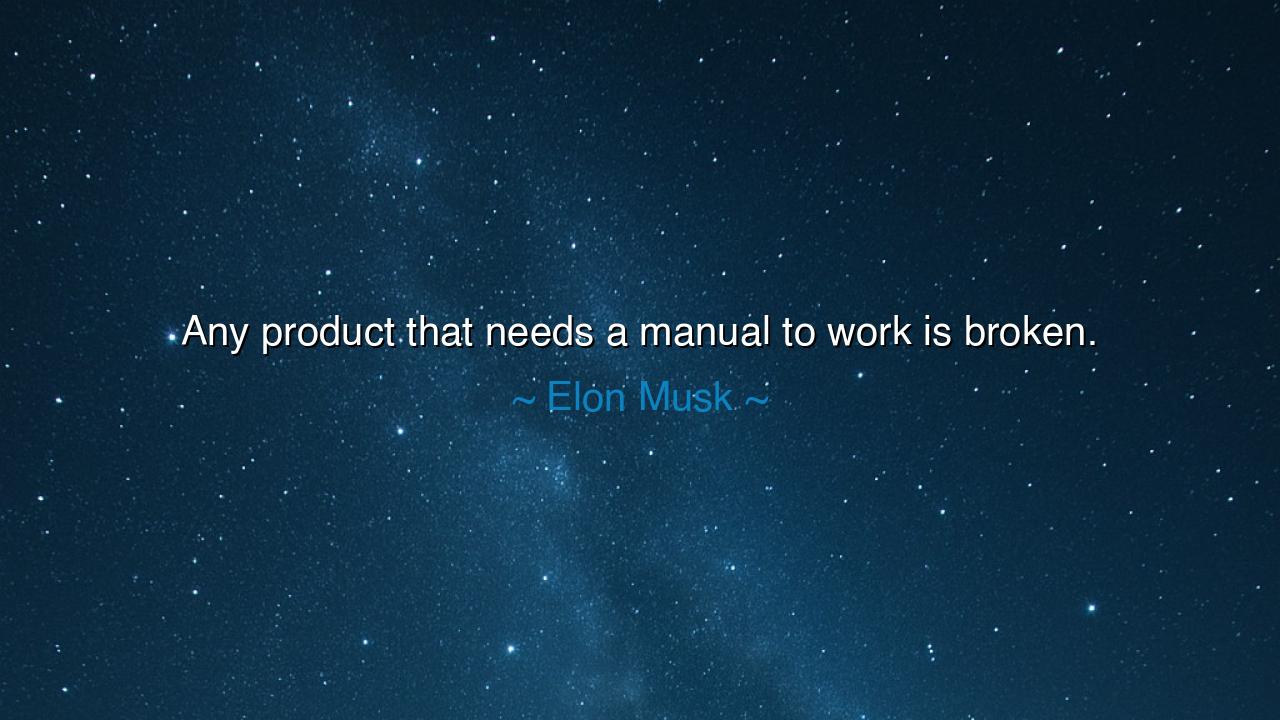
Any product that needs a manual to work is broken.






The modern inventor and visionary Elon Musk, a man who dreams of planets and builds the machines to reach them, once declared: “Any product that needs a manual to work is broken.” In these few, almost casual words, he spoke a truth that stretches far beyond technology — a truth about clarity, simplicity, and the unity between creator and user. For Musk, design is not merely about making things function; it is about making them intuitive, so that their purpose is immediately understood. A product that demands explanation has failed to speak its own language. A thing, no matter how clever, that cannot teach its use through its form, has lost its soul.
To understand these words, one must understand the worldview from which they arise. Musk stands in the lineage of inventors who saw technology as a bridge, not a barrier, between humanity and progress. In his world — of electric vehicles, reusable rockets, and neural networks — complexity is unavoidable, yet the goal remains simplicity. Every Tesla, every SpaceX spacecraft, hides beneath its sleek skin a labyrinth of mathematics, code, and physics. But to the person who touches it, it must feel effortless. It must respond as naturally as the body moves, as the voice speaks, as the mind thinks. For when technology demands a manual, it reveals that the designer has not yet learned the most sacred art: the art of empathy.
This principle echoes through the wisdom of the ancients, who believed that true beauty lies in clarity. The Greeks, in their temples and sculptures, built not to impress but to express — to make the divine feel human, and the complex feel inevitable. A column, a curve, a proportion — all spoke wordlessly of strength, balance, and grace. The philosopher Aristotle taught that “nature does nothing in vain.” Every form in nature has a purpose that explains itself — the wing invites flight, the eye invites sight, the hand invites touch. So too, the greatest works of design should need no explanation. They should speak to instinct, to intuition, to that ancient knowing within us that understands truth without words.
In our own age, this wisdom has found expression in the work of Steve Jobs, the master of simplicity, whose ideals Musk himself often honors. When Jobs unveiled the first iPhone, he gave no instructions, no manuals, no lectures — he simply touched the screen, and the world understood. A device of immense complexity was made human through design. The act of touching, the most primal of gestures, became the key to infinite possibility. That is the perfection Musk demands: a technology so natural that it disappears, leaving only the joy of creation, the connection between human purpose and human tool.
But Musk’s quote carries also a deeper moral truth — one that applies to far more than machines. It speaks to the importance of transparency, of clarity in all things. Whether in leadership, art, or communication, when we must endlessly explain ourselves, it means our intent was not pure, our structure not sound. The great teacher, like the great inventor, does not obscure but illuminates. The great leader does not confuse but guides. In this way, the idea that a product “needing a manual is broken” becomes a metaphor for all human endeavors: that anything built without clarity of purpose, anything that cannot be understood by the heart as well as the mind, is incomplete.
There are moments in history that prove this truth. When Leonardo da Vinci designed his flying machines, they were so elegant that one could see, even without understanding the mechanics, what they were meant to do: they longed for the sky. When Brunelleschi raised the dome of Florence, its form explained its purpose — stability and light, order and ascension. In every age, the best creators speak not through words but through form, their work whispering: “This is what I am. This is what I do.” Musk’s creed stands in that same ancient tradition — the belief that design is language, and that if the language is broken, the understanding is lost.
So, my listener of the future, take this lesson into your own creation and your own life: simplicity is not the absence of depth, but the presence of truth. Whatever you build — be it a machine, a home, or a dream — build it so that it speaks for itself. Do not hide behind complexity; do not demand from others what your creation should already reveal. Let your work be like water — clear, fluid, and life-giving — flowing naturally toward understanding.
For in the end, as Elon Musk reminds us, a product that needs a manual is broken, not because manuals are evil, but because communication has failed. The greatest designs — and the greatest lives — are those that explain themselves through their being. When your purpose and your design are one, when clarity replaces confusion and function unites with grace, you will no longer need to speak of what you have made. It will speak for you — in silence, in simplicity, and in truth.






AAdministratorAdministrator
Welcome, honored guests. Please leave a comment, we will respond soon